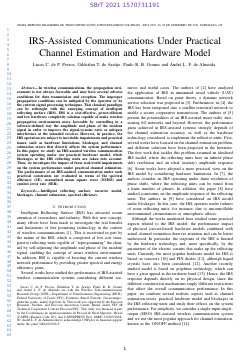
IRS-Assisted Communications Under Practical Channel Estimation and Hardware Model
Lucas Campos de Paula Pessoa, Gilderlan Tavares de Araújo, Paulo R. B. Gomes, André de Almeida
DOI: 10.14209/sbrt.2021.1570731191
Evento: XXXIX Simpósio Brasileiro de Telecomunicações e Processamento de Sinais (SBrT2021)
Keywords: Intelligent reflecting surface Varactor model Blockages Channel estimation
Abstract
In wireless communications, the propagation environment is not always favorable and may have several adverse conditions for data transmission and reception. The improper propagation conditions can be mitigated by the operator or by the current signal processing techniques. This classical paradigm can be rethought with the emerging concept of intelligent reflecting surface (IRS). IRS is a cost-effective, power-efficient and low hardware complexity solution capable of making wireless propagation environments more favorable by controlling in a software-defined way the amplitude and phase of the incident signal in order to improve the signal-to-noise ratio or mitigate interference at the intended receiver. However, in practice, the IRS operation are subject to inevitable impairments and practical issues such as hardware limitations, blockages, and channel estimation errors that directly affect the system performance. In this paper, we study an IRS-assisted wireless communication system operating under practical hardware model in which blockages at the IRS reflecting units are taken into account. Then, we investigate the impact of these real-world impairments on the system performance under practical channel estimation. The performance of an IRS-assisted communication under such practical constraints are evaluated in terms of the spectral efficiency (SE), normalized mean square error (NMSE) and symbol error rate (SER).Download